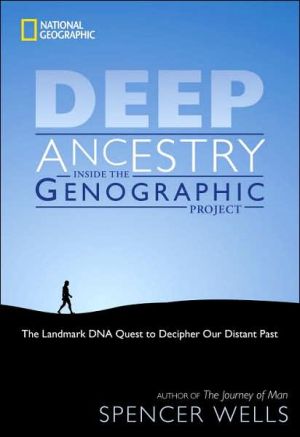Deep Ancestry: Inside the Genographic Project
Travel backward through time from today's scattered billions to the handful of early humans who lived in Africa 60,000 years ago and are ancestors to us all.\ In Deep Ancestry, scientist and National Geographic explorer Spencer Wells shows how tiny genetic changes add up over time into a fascinating story. Using scores of real-life examples, helpful analogies, and detailed diagrams and illustrations, he explains exactly how each and every individual's DNA contributes another piece to the...
Search in google:
Travel backward through time from today's scattered billions to the handful of early humans who lived in Africa 60,000 years ago and are ancestors to us all. In Deep Ancestry, scientist and National Geographic explorer Spencer Wells shows how tiny genetic changes add up over time into a fascinating story. Using scores of real-life examples, helpful analogies, and detailed diagrams and illustrations, he explains exactly how each and every individual's DNA contributes another piece to the jigsaw puzzle of human history. The book takes readers inside the Genographic Project—the landmark study now assembling the world's largest collection of DNA samples and employing the latest in testing technology and computer analysis to examine hundreds of thousand of genetic profiles from all over the globe—and invites us all to take part. Library Journal The Genographic Project is an ambitious five-year effort to map humanity's evolutionary journey from our common African origins through the study of genetic markers. Project director and geneticist Wells (The Journey of Man) uses case studies of five individuals to illustrate what can be learned from population genetics. He also provides accessible introductions to evolving, cutting-edge scientific concepts like haplogroups, mitochondrial DNA, Y chromosomes, and genetic drift. As Wells explains, the Genographic Project offers ordinary citizens the chance to participate and contribute DNA for analysis for $99.95, an exchange that includes a DVD, a cheek-swab kit, and a confidential Genographic Project ID number to retrieve results. The people behind this project seem to have learned from previous studies, which were criticized as racist. What won't be learned from these genetic analyses (traits linked to diseases) is pretty straightforward, as explained by Wells. They deliberately leave out any analysis of disease traits, medical applications, and other potentially commercial applications. We certainly have much to learn yet about populations, and this book may help. Recommended for libraries with collections in popular science. (Illustrations not seen.)-Mary Chitty, Cambridge Healthtech, Needham, MA Copyright 2006 Reed Business Information.
Introduction 1The Block 9Odine's Story: The Exception 27Margaret's Story: The Hearth 55Phil's Story: The Ice 85Virumandi's Story: The Beach 115Julius's Story: The Cradle 133Epilogue 163Haplogroup Descriptions 175Glossary 229Further Reading 235About the Author 238Author Acknowledgments and Illustration Credits 240Index 242
\ From Barnes & NobleThe Genographic Project is a five-year study that will utilize the world's largest collection of DNA samples to discover patterns of early human migration. This research, which is the largest scientific endeavor since the mapping of the human genome, can place individuals within the vast epic of human origins and migration. Deep Ancestry: Inside the Genographic Project translates forbidding genetic concepts into accessible language, enabling readers to gain a grasp of the significant findings already uncovered by this landmark study. Some of the conclusions will come as revelations: Few readers know, for example, that Australia was settled before Europe or that Europe was settled from Asia, not from nearby Africa.\ \ \ \ \ Library JournalThe Genographic Project is an ambitious five-year effort to map humanity's evolutionary journey from our common African origins through the study of genetic markers. Project director and geneticist Wells (The Journey of Man) uses case studies of five individuals to illustrate what can be learned from population genetics. He also provides accessible introductions to evolving, cutting-edge scientific concepts like haplogroups, mitochondrial DNA, Y chromosomes, and genetic drift. As Wells explains, the Genographic Project offers ordinary citizens the chance to participate and contribute DNA for analysis for $99.95, an exchange that includes a DVD, a cheek-swab kit, and a confidential Genographic Project ID number to retrieve results. The people behind this project seem to have learned from previous studies, which were criticized as racist. What won't be learned from these genetic analyses (traits linked to diseases) is pretty straightforward, as explained by Wells. They deliberately leave out any analysis of disease traits, medical applications, and other potentially commercial applications. We certainly have much to learn yet about populations, and this book may help. Recommended for libraries with collections in popular science. (Illustrations not seen.)-Mary Chitty, Cambridge Healthtech, Needham, MA Copyright 2006 Reed Business Information.\ \








